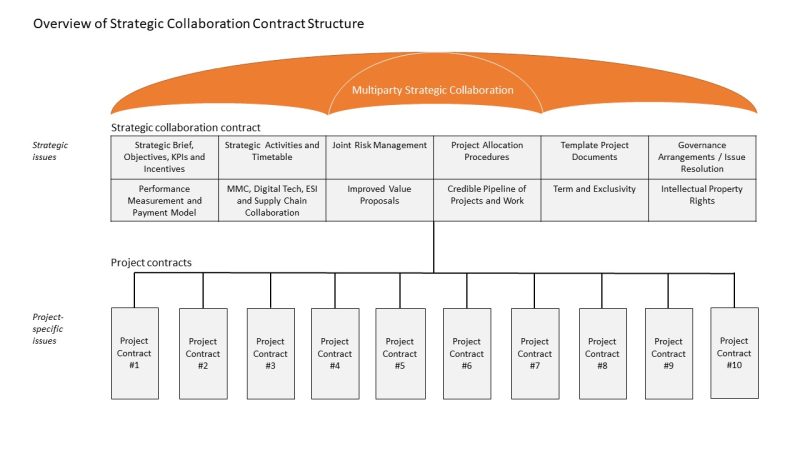Improving construction outcomes through strategic collaboration contracts
Posted: 23rd February 2022
Posted in: Blog

Posted: 23rd February 2022
Posted in: Blog
The UK Government’s recent review of framework contracts – Constructing the Gold Standard – An Independent Review of Public Sector Construction Frameworks – provides important insights on how strategic collaboration contracts could be used by the Australian construction sector to continuously improve construction outcomes, including by breaking the cycle of lost learning, reducing the sector’s excessive reliance on competitive tendering and leveraging the prospect of further work to attract increased supplier commitments to productivity enhancing investments.
A strategic collaboration contract is a long-term multi-party contract that an asset owner puts in place with its panel of contractors/suppliers. A diagrammatic overview of the structure is shown below:

The strategic collaboration contract is built around the asset owner’s forward project and work program, and the actions that the parties will take to improve value over the course of its delivery, including between project awards.
A credible pipeline of work is needed to drive strategic planning, investment and continuous improvement from all involved. Without it, the confidence that suppliers need, that they will obtain a fair return on the investments involved in implementing actions to improve value, will be lacking.
A strategic collaboration contract should:
Strategic collaboration contracts are rare in the Australian construction sector, although the Level Crossing Removal Programme, the MRPV’s Program Delivery Approach and Sydney Water’s Partnering for Success approach are notable exceptions.
The long-term nature of strategic collaboration contracts, coupled with their focus on longer-term initiatives that can be progressed before, during and in-between projects, can break the cycle of lost learning that occurs (as project teams disband following each project) and harness the power of aligned interests to continuously improve value and risk management over the long term.
With a credible long-term pipeline of work, strategic collaboration contracts can underwrite investments that will deliver productivity improvements over the longer term including the development and use of digital technologies and offsite manufacturing.
Strategic collaboration contracts can promote early supply chain involvement (ESI), which extends the concept of early contractor involvement (ECI) by formally engaging the tier 1 contractor(s) alongside tier 2 and tier 3 subcontractors and suppliers in the pre-construction phase to provide input into the design, costing, risk management and structuring of a project. The UK review found that despite a wealth of evidence that ESI improves value (by about 10% on average), the worrying trend is that many project owners do not adopt ESI for project awards because of the cost and time involved.
Depending on the scope of the strategic collaboration, different projects may demand different delivery models. The strategic collaboration contract could:
The strategic collaboration contract should attach or identify the form(s) of project contract that will be used for different delivery models to provide consistent foundations and create mutual confidence, avoid the wasted cost and time required to implement multiple bespoke forms, and provide a consistent basis for training, guidance and exchanges of experience.
Finally, properly deployed and supported with ‘should cost benchmarks’ and appropriate anti-corruption mechanisms, strategic collaboration contracts can also provide the mechanisms that Australian project owners need to overcome their excessive use of competitively tendered fixed price project contracts to demonstrate value for money, and the associated waste of scarce losing bidder resources.
Guest author: Owen Hayford, Principal, Infralegal
This article is based on a more detailed paper that Owen Hayford has prepared that can be accessed here.
Owen’s paper draws from the UK review report authored by Professor David Mosey – Constructing the Gold Standard – An Independent Review of Public Sector Construction Frameworks – which can be accessed at here.
.